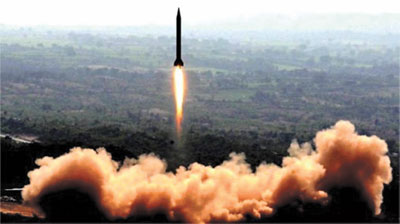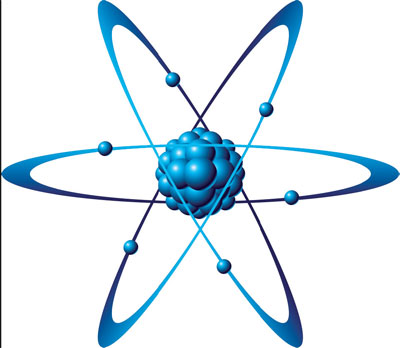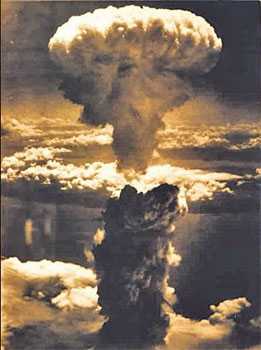
Atom – the mighty midget
The atoms power nuclear weapons:
 An
atom is incredibly small and hard, has enormous power but yet is made
mostly of space. It is the tiny, invisible particle of which everything
is made of. That is why it is considered mighty. An
atom is incredibly small and hard, has enormous power but yet is made
mostly of space. It is the tiny, invisible particle of which everything
is made of. That is why it is considered mighty.
Now what do you think the size of an atom is? It is about a millionth
of a millimetre across. If you think that it is small, then you may not
be aware of yet another thing, which is even smaller. The nucleus,
another particle in the centre of every atom is 10,000 times smaller
than the atom!
Between the nucleus and the outside of the atom, it is mostly empty
space. The rest of the atom too is not solid, but consists of one or
more electrons moving around the nucleus. They are even smaller still –
a tenth the size of a nucleus.

So, how can an atom, so small and hard have such enormous power? The
answer is the electrons which have an electric charge. The electric
force of an atom pushes away the electrons of any other atom that comes
near it, making it difficult to penetrate the atom. However, in nuclear
power it is different. Penetration does happen and the nucleus is
affected, either splitting it apart or fusing with another nucleus. And
these are held together by an extremely strong force. So, when the
nucleus is disrupted this strong force is released, producing great
energy. This is why the strong force is called nuclear power. It is
immensely powerful.
An atom is the smallest particle into which a chemical can be divided
without losing its chemical properties.
What's so special about nuclear power? Its extreme power of course.
Nuclear power or atomic energy as it's also called, produces energy in
far greater amounts than any other source of power.
|

A nuclear bomb |
This energy is used to produce weapons of mass destruction or
generate electricity. Nuclear power stations use only small quantities
of nuclear fuels such as uranium instead of the huge amounts of coal and
fuel burned by other power stations to generate electricity.
Nuclear weapons on the other hand use the immense strength of nuclear
power to destroy us. Nuclear weapons also produce dangerous radiation,
as does waste from nuclear power stations.
How powerful were the first nuclear weapons? They were extremely
powerful. The first nuclear weapons, two atomic bombs were dropped on
the cities of Hiroshima and Nagasaki by the United States of America
during the World War, in 1945. The bombs killed a total of more than
200,000 people. The atomic bombs each had a power of 20 kilotons. This
means that their explosive power was equal to that of 20,000 tons of the
high explosive TNT. Many countries have nuclear weapons today. The most
powerful of nuclear weapons have powers measured in mega tons (millions
of tons of TNT) and are about a thousand times more powerful than the
bombs dropped on Japan. That is why no nuclear weapons have been used
since then.
Fact
file__________________________________
*All physical matter is made up of one or more of 92 known elements,
as can be seen on a Periodic Table of Elements in any biology or
chemistry textbook. Many of these elements are well known to most
people: carbon, hydrogen, oxygen, gold and silver while other elements,
such as iridium and rhodium, are not so well known.
* Elements are made up of atoms that have unique properties to that
element, so that the atoms of carbon are physically and chemically
different from the atoms of gold.
|

A nuclear explosion |
* Atoms can be thought of as miniature solar systems: atoms have a
core or nucleus composed of positively charged subatomic particles
called protons and neutral subatomic particles called neutrons.
* Orbiting the nucleus are negatively charged electrons. The
electrons are held in orbitals around the nucleus due to the attraction
between the positive charge of the protons and the negative charge of
the electrons.
*Atoms bond to each other by either sharing or donating/accepting
electrons in their outermost orbital, also known as the valence shell.
* A nuclear weapon is a device that gets its destructive power from
the transformation of matter in atoms into energy. There are two types
of nuclear weapons: fission weapons and fusion weapons.
* Only two nuclear weapons have been used in the course of warfare,
both by the United States near the end of World War II. On August 6 ,
1945, a uranium gun-type fission bomb code-named “Little Boy” was
detonated over the Japanese city of Hiroshima. Three days later, on
August 9 , a plutonium implosion-type fission bomb code-named “Fat Man”
was exploded over Nagasaki, Japan.
* The Soviet Union tested their first atomic bomb in 1949, the
British tested their first atomic bomb in 1952, France in 1960, China in
1964, India in 1974 and Pakistan in 1998.
* Since the advent of nuclear weapons, humans are included in the
list of endangered species. There are about 26,000 nuclear warheads
ready to be launched at any time. Nuclear weapons can destroy entire
civilizations in the world.
* More than 95 per cent of nuclear weapons and atomic bombs are owned
by the United States and Russia. Other countries that have nuclear
weapons are Britain, France, China, Israel, India, Pakistan and North
Korea. |



